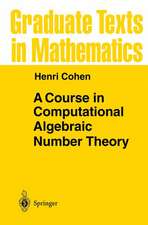A Course in Constructive Algebra: Universitext
Autor Ray Mines, Fred Richman, Wim Ruitenburgen Limba Engleză Paperback – 18 dec 1987
Din seria Universitext
- 13%
 Preț: 353.48 lei
Preț: 353.48 lei -
 Preț: 418.67 lei
Preț: 418.67 lei -
 Preț: 465.61 lei
Preț: 465.61 lei -
 Preț: 371.98 lei
Preț: 371.98 lei - 17%
 Preț: 394.41 lei
Preț: 394.41 lei -
 Preț: 356.77 lei
Preț: 356.77 lei - 17%
 Preț: 364.56 lei
Preț: 364.56 lei - 15%
 Preț: 543.75 lei
Preț: 543.75 lei - 15%
 Preț: 497.21 lei
Preț: 497.21 lei -
 Preț: 634.38 lei
Preț: 634.38 lei -
 Preț: 396.53 lei
Preț: 396.53 lei - 17%
 Preț: 431.50 lei
Preț: 431.50 lei - 13%
 Preț: 355.51 lei
Preț: 355.51 lei -
 Preț: 360.07 lei
Preț: 360.07 lei - 17%
 Preț: 365.34 lei
Preț: 365.34 lei -
 Preț: 358.44 lei
Preț: 358.44 lei - 15%
 Preț: 553.33 lei
Preț: 553.33 lei - 17%
 Preț: 364.81 lei
Preț: 364.81 lei -
 Preț: 673.45 lei
Preț: 673.45 lei - 15%
 Preț: 509.58 lei
Preț: 509.58 lei - 17%
 Preț: 427.32 lei
Preț: 427.32 lei - 17%
 Preț: 426.76 lei
Preț: 426.76 lei - 17%
 Preț: 427.68 lei
Preț: 427.68 lei - 20%
 Preț: 569.54 lei
Preț: 569.54 lei - 19%
 Preț: 429.21 lei
Preț: 429.21 lei - 17%
 Preț: 369.06 lei
Preț: 369.06 lei - 15%
 Preț: 737.46 lei
Preț: 737.46 lei - 13%
 Preț: 389.95 lei
Preț: 389.95 lei -
 Preț: 487.96 lei
Preț: 487.96 lei - 20%
 Preț: 628.22 lei
Preț: 628.22 lei -
 Preț: 372.86 lei
Preț: 372.86 lei -
 Preț: 319.07 lei
Preț: 319.07 lei -
 Preț: 379.86 lei
Preț: 379.86 lei -
 Preț: 445.88 lei
Preț: 445.88 lei -
 Preț: 382.36 lei
Preț: 382.36 lei - 15%
 Preț: 533.72 lei
Preț: 533.72 lei - 15%
 Preț: 496.02 lei
Preț: 496.02 lei - 15%
 Preț: 474.82 lei
Preț: 474.82 lei -
 Preț: 389.70 lei
Preț: 389.70 lei -
 Preț: 484.08 lei
Preț: 484.08 lei - 15%
 Preț: 469.41 lei
Preț: 469.41 lei -
 Preț: 415.02 lei
Preț: 415.02 lei - 15%
 Preț: 602.25 lei
Preț: 602.25 lei - 20%
 Preț: 510.24 lei
Preț: 510.24 lei - 15%
 Preț: 588.37 lei
Preț: 588.37 lei -
 Preț: 381.59 lei
Preț: 381.59 lei -
 Preț: 489.87 lei
Preț: 489.87 lei -
 Preț: 493.89 lei
Preț: 493.89 lei
Preț: 643.48 lei
Preț vechi: 757.04 lei
-15% Nou
Puncte Express: 965
Preț estimativ în valută:
123.13€ • 128.56$ • 101.91£
123.13€ • 128.56$ • 101.91£
Carte tipărită la comandă
Livrare economică 04-18 aprilie
Preluare comenzi: 021 569.72.76
Specificații
ISBN-13: 9780387966403
ISBN-10: 0387966404
Pagini: 344
Ilustrații: XI, 344 p. 1 illus.
Dimensiuni: 155 x 235 x 19 mm
Greutate: 0.5 kg
Ediția:1988
Editura: Springer
Colecția Springer
Seria Universitext
Locul publicării:New York, NY, United States
ISBN-10: 0387966404
Pagini: 344
Ilustrații: XI, 344 p. 1 illus.
Dimensiuni: 155 x 235 x 19 mm
Greutate: 0.5 kg
Ediția:1988
Editura: Springer
Colecția Springer
Seria Universitext
Locul publicării:New York, NY, United States
Public țintă
ResearchCuprins
I. Sets.- 1. Constructive vs. classical mathematics.- 2. Sets, subsets and functions.- 3. Choice.- 4. Categories.- 5. Partially ordered sets and lattices.- 6. Well-founded sets and ordinals.- II. Basic Algebra.- 1. Groups.- 2. Rings and fields.- 3. Real numbers.- 4. Modules.- 5. Polynomial rings.- 6. Matrices and vector spaces.- 7. Determinants.- 8. Symmetric polynomials.- III. Rings And Modules.- 1. Quasi-regular ideals.- 2. Coherent and Noetherian modules.- 3. Localization.- 4. Tensor products.- 5. Flat modules.- 6. Local rings.- 7. Commutative local rings.- IV. Divisibility in Discrete Domains.- 1. Cancellation monoids.- 2. UFD's and Bézout domains.- 3. Dedekind-Hasse rings and Euclidean domains.- 4. Polynomial rings.- V. Principal Ideal Domains.- 1. Diagonalizing matrices.- 2. Finitely presented modules.- 3. Torsion modules, p-components, elementary divisors.- 4. Linear transformations.- VI. Field Theory.- 1. Integral extensions and impotent rings.- 2. Algebraic independence and transcendence bases.- 3. Splitting fields and algebraic closures.- 4. Separability and diagonalizability.- 5. Primitive elements.- 6. Separability and characteristic p.- 7. Perfect fields.- 8. Galois theory.- VII. Factoring Polynomials.- 1. Factorial and separably factorial fields.- 2. Extensions of (separably) factorial fields.- 3. Condition p.- 4. The fundamental theorem of algebra.- VIII. Commutative Noetherian Rings.- 1. The Hilbert basis theorem.- 2. Noether normalization and the Artin-Rees lemma.- 3. The Nullstellensatz.- 4. Tennenbaum' s approach to the Hilbert basis theorem.- 5. Primary ideals.- 6. Localization.- 7. Primary decomposition.- 8. Lasker-Noether rings.- 9. Fully Lasker-Noether rings.- 10. The principal ideal theorem.- IX. Finite Dimensional Algebras.- 1. Representations.- 2. The density theorem.- 3. The radical and summands.- 4. Wedderburn's theorem, part one.- 5. Matrix rings and division algebras.- X. Free Groups.- 1. Existence and uniqueness.- 2. Nielsen sets.- 3.Finitely generated subgroups.- 4. Detachable subgroups of finite-rank free groups.- 5. Conjugate subgroups.- XI. Abelian Groups.- 1. Finite-rank torsion-free groups.- 2. Divisible groups.- 3. Height functions on p-groups.- 4. Ulm's theorem.- 5. Construction of Ulm groups.- XII. Valuation Theory.- 1. Valuations.- 2. Locally precompact valuations.- 3. Pseudofactorial fields.- 4. Normed vector spaces.- 5. Real and complex fields.- 6. Hensel's lemma.- 7. Extensions of valuations.- 8. e and f.- XIII. Dedekind Domains.- 1. Dedekind sets of valuations.- 2. Ideal theory.- 3. Finite extensions.












